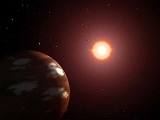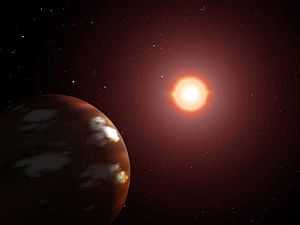
Gliese 436 b
Encyclopedia
Gliese 436 b is a Neptune
-sized extrasolar planet
orbiting the red dwarf star Gliese 436. It was among the smallest known transiting planets in mass and radius until the much smaller Kepler discoveries started coming in 2010.
and Geoffrey Marcy
of the Carnegie Institute of Washington and University of California, Berkeley, respectively, using the radial velocity method
. Together with 55 Cancri e
, it was then the first of a new class of planets with a minimum mass (M sini) similar to Neptune.
The planet was recorded to transit
its star by an automatic process at NMSU on January 11, 2005, but this event went unheeded at the time. In 2007, Gillon led a team which observed the transit, grazing the stellar disc relative to Earth. Transit observations led to the determination of Gliese 436 b's exact mass and radius, both of which are very similar to Neptune. Gliese 436 b then became the smallest known transiting extrasolar planet. The planet is about 4000 km larger in diameter than Uranus and 5000 km larger than Neptune and a bit more massive. Gliese 436b (also known as GJ 436b) orbits its star at a distance of 4,000,000 km or 15 times closer than Mercury's average distance from the sun.
 One orbit around the star takes only about 2 day
One orbit around the star takes only about 2 day
s, 15.5 hour
s. The planet's surface temperature is estimated from measurements taken as it passes behind the star to be 712 K (439 °C). This temperature is significantly higher than would be expected if the planet were only heated by radiation from its star (which had been, in a Reuters article from a month prior to this measurement, estimated at 520 K). Whatever energy that tidal effects deliver to the planet does not notably affect its temperature. Its discoverers allowed for a temperature increase due to a greenhouse effect.
Its main constituent was initially predicted to be hot "ice
" in various exotic high-pressure forms, which remains solid because of the planet's gravity despite the high temperatures. The planet could have formed further from its current position, as a gas giant, and migrated inwards with the other gas giants. As it arrived in range, the star would have blown off the planet's hydrogen layer via coronal mass ejection
.
However when the radius became better known, ice alone was not enough to account for it. An outer layer of hydrogen
and helium
up to ten percent in mass would be needed on top of the ice to account for the observed planetary radius. This obviates the need for an ice core. Alternatively, the planet may be a super-earth
.
Observations of the planet's brightness temperature
with the Spitzer Space Telescope
suggest a possible thermochemical disequilibrium in the atmosphere of this exoplanet. Results published in Nature suggest that Gliese 436b's atmosphere is abundant in CO and deficient in methane (CH4) by a factor of ~7,000. This result is unexpected because, based on current models at this temperature, the atmospheric carbon should prefer CH4 over CO.

Neptune
Neptune is the eighth and farthest planet from the Sun in the Solar System. Named for the Roman god of the sea, it is the fourth-largest planet by diameter and the third largest by mass. Neptune is 17 times the mass of Earth and is slightly more massive than its near-twin Uranus, which is 15 times...
-sized extrasolar planet
Extrasolar planet
An extrasolar planet, or exoplanet, is a planet outside the Solar System. A total of such planets have been identified as of . It is now known that a substantial fraction of stars have planets, including perhaps half of all Sun-like stars...
orbiting the red dwarf star Gliese 436. It was among the smallest known transiting planets in mass and radius until the much smaller Kepler discoveries started coming in 2010.
Discovery
Gliese 436 b was discovered in August 2004 by R. Paul ButlerR. Paul Butler
R. Paul Butler is an astronomer who searches for extrasolar planets.He received a BA and an MS from San Francisco State University, completing a Master's thesis with Geoffrey Marcy, and then completed his doctoral studies at the University of Maryland, College Park in 1993...
and Geoffrey Marcy
Geoffrey Marcy
Geoffrey W. Marcy is an American astronomer, who is currently Professor of Astronomy at the University of California, Berkeley, famous for discovering more extrasolar planets than anyone else, 70 out of the first 100 to be discovered, along with R...
of the Carnegie Institute of Washington and University of California, Berkeley, respectively, using the radial velocity method
Methods of detecting extrasolar planets
Any planet is an extremely faint light source compared to its parent star. In addition to the intrinsic difficulty of detecting such a faint light source, the light from the parent star causes a glare that washes it out...
. Together with 55 Cancri e
55 Cancri e
55 Cancri e is an extrasolar planet with half the mass of Neptune orbiting the Sun-like star 55 Cancri A. Its mass is about 8.3 Earth masses, thus classifying it as the first Super-Earth discovered around a main sequence star, predating Gliese 876 d by a year...
, it was then the first of a new class of planets with a minimum mass (M sini) similar to Neptune.
The planet was recorded to transit
Astronomical transit
The term transit or astronomical transit has three meanings in astronomy:* A transit is the astronomical event that occurs when one celestial body appears to move across the face of another celestial body, hiding a small part of it, as seen by an observer at some particular vantage point...
its star by an automatic process at NMSU on January 11, 2005, but this event went unheeded at the time. In 2007, Gillon led a team which observed the transit, grazing the stellar disc relative to Earth. Transit observations led to the determination of Gliese 436 b's exact mass and radius, both of which are very similar to Neptune. Gliese 436 b then became the smallest known transiting extrasolar planet. The planet is about 4000 km larger in diameter than Uranus and 5000 km larger than Neptune and a bit more massive. Gliese 436b (also known as GJ 436b) orbits its star at a distance of 4,000,000 km or 15 times closer than Mercury's average distance from the sun.
Physical characteristics

Day
A day is a unit of time, commonly defined as an interval equal to 24 hours. It also can mean that portion of the full day during which a location is illuminated by the light of the sun...
s, 15.5 hour
Hour
The hour is a unit of measurement of time. In modern usage, an hour comprises 60 minutes, or 3,600 seconds...
s. The planet's surface temperature is estimated from measurements taken as it passes behind the star to be 712 K (439 °C). This temperature is significantly higher than would be expected if the planet were only heated by radiation from its star (which had been, in a Reuters article from a month prior to this measurement, estimated at 520 K). Whatever energy that tidal effects deliver to the planet does not notably affect its temperature. Its discoverers allowed for a temperature increase due to a greenhouse effect.
Its main constituent was initially predicted to be hot "ice
Ice
Ice is water frozen into the solid state. Usually ice is the phase known as ice Ih, which is the most abundant of the varying solid phases on the Earth's surface. It can appear transparent or opaque bluish-white color, depending on the presence of impurities or air inclusions...
" in various exotic high-pressure forms, which remains solid because of the planet's gravity despite the high temperatures. The planet could have formed further from its current position, as a gas giant, and migrated inwards with the other gas giants. As it arrived in range, the star would have blown off the planet's hydrogen layer via coronal mass ejection
Coronal mass ejection
A coronal mass ejection is a massive burst of solar wind, other light isotope plasma, and magnetic fields rising above the solar corona or being released into space....
.
However when the radius became better known, ice alone was not enough to account for it. An outer layer of hydrogen
Hydrogen
Hydrogen is the chemical element with atomic number 1. It is represented by the symbol H. With an average atomic weight of , hydrogen is the lightest and most abundant chemical element, constituting roughly 75% of the Universe's chemical elemental mass. Stars in the main sequence are mainly...
and helium
Helium
Helium is the chemical element with atomic number 2 and an atomic weight of 4.002602, which is represented by the symbol He. It is a colorless, odorless, tasteless, non-toxic, inert, monatomic gas that heads the noble gas group in the periodic table...
up to ten percent in mass would be needed on top of the ice to account for the observed planetary radius. This obviates the need for an ice core. Alternatively, the planet may be a super-earth
Super-Earth
A super-Earth is an extrasolar planet with a mass higher than Earth's, but substantially below the mass of the Solar System's gas giants. The term super-Earth refers only to the mass of the planet, and does not imply anything about the surface conditions or habitability...
.
Observations of the planet's brightness temperature
Brightness temperature
Brightness temperature is the temperature a black body in thermal equilibrium with its surroundings would have to be to duplicate the observed intensity of a grey body object at a frequency \nu....
with the Spitzer Space Telescope
Spitzer Space Telescope
The Spitzer Space Telescope , formerly the Space Infrared Telescope Facility is an infrared space observatory launched in 2003...
suggest a possible thermochemical disequilibrium in the atmosphere of this exoplanet. Results published in Nature suggest that Gliese 436b's atmosphere is abundant in CO and deficient in methane (CH4) by a factor of ~7,000. This result is unexpected because, based on current models at this temperature, the atmospheric carbon should prefer CH4 over CO.
Orbital characteristics
This planet should not be as eccentric as is measured. To have maintained its eccentricity over time requires that it be accompanied by another planet. In September 2008, a formerly-unrecognised transit signature at NMSU from January 11, 2005 was incorporated into the data up to then, consistent with a planet at 0.08 AU and under 12 Earth masses.Selected media articles
- How Do Artists Portray Exoplanets They've Never Seen? 4/9, Scientific American October 2, 2007.
- Astronomers Detect Shadow Of Water World In Front Of Nearby Star (from Science DailyScience DailyScience Daily is a news website for topical science articles. It features articles on a wide variety of science topics including: astronomy, exoplanets, computer science, nanotechnology, medicine, psychology, sociology, anthropology, biology, geology, climate, space, physics, mathematics,...
).
External links


